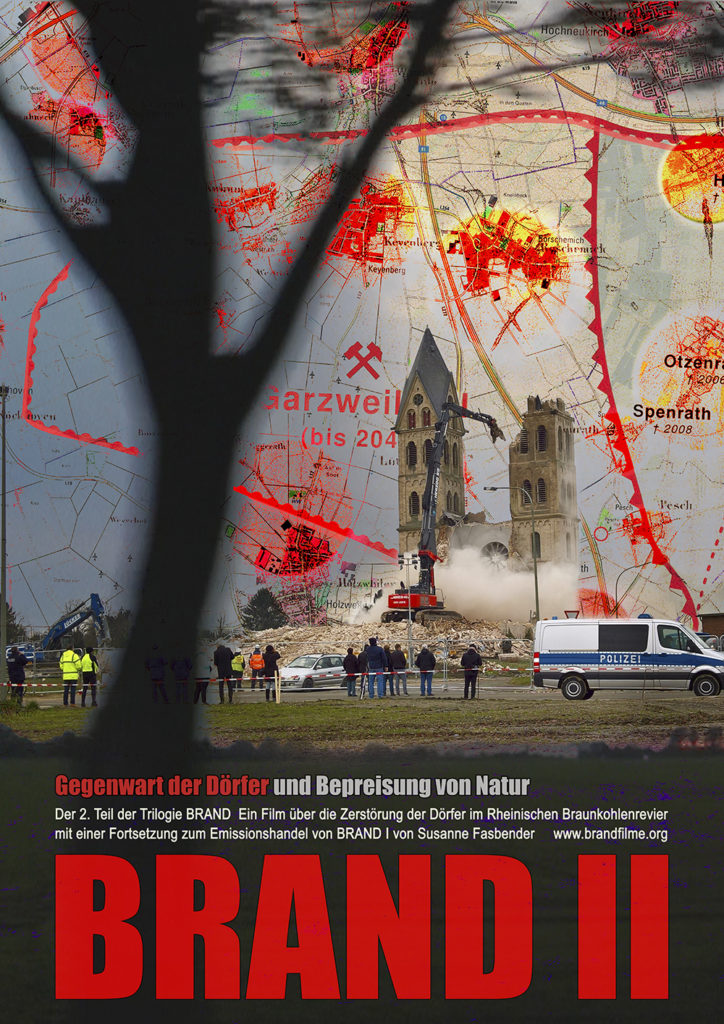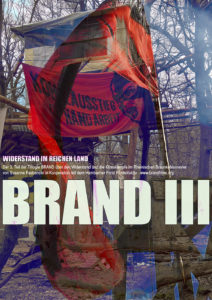
The Trilogy BRAND(Fire)
A Journey into coal mining in Germany and a journey of thought to the core of the ecological crisis.
A film trilogy about the fossil fuel economy, brown coal (lignite), climate policy and the resistance in the Rhineland. By Susanne Fasbender in cooperation with the Hambach Forest Film Collective. Each of the three films stands independent of the others. As a trilogy, they create a new entity; each film awards depth to the others. streaming here
Artist Susanne Fasbender has travelled through the Rhenish Lignite Area and created an in-depth comprehensive work of film in three parts. The way her work analytically comprehends the links between resource extraction, land grabbing, economic growth and the climate crisis is impressive.

The landscape of Erkelenz will be destroyed
“Relating and recognising – the Trilogy BRAND manages the feat of combining a ‘journey into coal mining in Germany’ with a ‘journey of thought to the core of the ecological crisis.’ The film does not reduce the concrete fates of expulsion, the disappearance of entire natural landscapes and habitats, on the contrary, it augments them with a clear-sighted analyses of our economic activity founded on fossil energies and international climate policy with its unparalleled commodification of nature.” Dr. Frauke Tomczak, Scholar of Film, Author and Lecturer
"The Trilogy BRAND is a valuable, comprehensive contribution to making us think about the environmental crisis. Studying social and ecological issues in a fruitful manner, making them truly accessible through a systematically structured approach, in order to communicate essential knowledge for increased democratic participation, while not forgetting her roots within the arts, all this requires time and patience both of which the director took and used to good effect." Prof. Dr. Sabine Rollberg (Former Editor-in-Chief of channel ARTE)
Many thanks to all interview partners and participants! The films could only be made with the highly exciting contributions of scientists, activists and citizens.
BRAND (FIRE) I On Property Rights to Land and Forests
“We are kidding ourselves if we believe we'll be able to find and realise quick solutions, easy solutions that don't hurt anyone, and that all of us can sign without resistance. Because privileges are at stake that we appropriated and got used to over the past 500 years. And we are not just going to want to give these up. That's why, in the old Europe, we are struggling much more with debates on alternatives and with having the courage to think, and to allow ourselves to have these discussions on how we are imagining a good life in the future.” Quote Jutta Kill In BRAND (FIRE) I. She a biologist and has done research on several climate protection projects.
 Artist Susanne Fasbender has travelled through the Coal Country Rhineland and created an in-depth comprehensive work of film in three parts. BRAND (FIRE) I: Her work analytically comprehends the links between resource extraction, land grabbing, economic growth and the climate crisis. She skilfully combines her subjective point of view which, in light of being impressed with impeding climate change, is indeed emotional, with a scenic language that pervades the film in a fundamentally unagitated manner. The images are given pace and time, bringing viewers into reach of the land and villages to be sacrificed to lignite extraction. Through the participation of numerous people affected or actively intervening, viewers are brought to feel the magnitude of the situation. As well as being given the opportunity to dive into local circumstances, structured, analytical interviews that accompany every turn of events gain the viewer an understanding of the exemplary nature of the area, characterised by industrial development and ecological destruction.
Artist Susanne Fasbender has travelled through the Coal Country Rhineland and created an in-depth comprehensive work of film in three parts. BRAND (FIRE) I: Her work analytically comprehends the links between resource extraction, land grabbing, economic growth and the climate crisis. She skilfully combines her subjective point of view which, in light of being impressed with impeding climate change, is indeed emotional, with a scenic language that pervades the film in a fundamentally unagitated manner. The images are given pace and time, bringing viewers into reach of the land and villages to be sacrificed to lignite extraction. Through the participation of numerous people affected or actively intervening, viewers are brought to feel the magnitude of the situation. As well as being given the opportunity to dive into local circumstances, structured, analytical interviews that accompany every turn of events gain the viewer an understanding of the exemplary nature of the area, characterised by industrial development and ecological destruction.
The film directly invites its audience to partake in a civil-society discourse that is indispensable for the future of humans and nature. Fasbender maps out the North-South link in the environmental crisis in this multi-piece work. Further, she demands a discourse within society on the commercialisation of nature under the guise of carbon trading. Of imperative importance, yet barely paid attention to is that the fact that emissions trading is supposed to align the fulfilment of ambitious economic goals with a reduction in greenhouse gas and other gas emissions harmful to the environment and humans. (S. Rollberg, see above.)
At the latest when we’ve realised that international climate policy, as has been embedded into economics, follows the very same legitimacy of land appropriation and capital valorization, it will become evident that a much more in depth understanding of the relationships is required. The fact that things haven’t improved after 23 climate conferences suggests that the actual issue is barely touched upon by the often lamented ‘They talk loads and do nought’. On the contrary: much more is being done and legally established than we realise from within the general climate debates; the guiding concept ‘Better Growth, Better Climate’ does safe-guard certain interests, and not by accident.
"Have they stopped exploring for oil? No. Have they stopped trying to push for mining in pristine areas? No. Have they stopped exploiting shale oil? No. Have they stopped fracking? No. Why are they doing this? Because they better do it now and quickly, because the game might change in the future. So should we expect anything to happen on the COP in Paris to change the situation? No. Because noone is prepared to take on the fossil fuel economy. That is a restructuring of the society and the economy that is essential to do anything serious about greenhouse gas emissions. So either you deride the problem and you ignore it or you take it seriously."
Quote Prof. Dr. Clive L. Spash in BRAND I. He is the Publisher of the Routledge Handbook of Ecological Economics: Nature and Society, Editor-in-chief of the journal "Environmental Values". Chair for Public Policy and Governance, Vienna University of Economics and Business.
Runtime 109 minutes
BRAND (FIRE) II Presence of old places and costing nature
 BRAND ll portrays the destruction of a century-old cultural landscape for the extraction of lignite in the Rhineland up until 2027. It makes the scope of this existential interference tangible: forced displacement and the knowledge that the place you call home is being put to waste - everything down to language, traditional crafts, and several hundreds of years old family histories.
BRAND ll portrays the destruction of a century-old cultural landscape for the extraction of lignite in the Rhineland up until 2027. It makes the scope of this existential interference tangible: forced displacement and the knowledge that the place you call home is being put to waste - everything down to language, traditional crafts, and several hundreds of years old family histories.
The decade-long, domineering seizure of land has deeply marked the character of the region. Everything appears violated or remains in tragic expectation. The coming destruction of what lies restfully is equally omnipresent in the still inhabited villages. The already uninhabited villages have been abandoned by people, while birds accompany the wild growth in gardens and parks with their song. The count-less, ancient high trees that dress the old localities will be removed first of all when demolition starts.
The conversation about the societal relationship to nature, the Kyoto Protocol and the concept of the imperial mode of living will be continued and interwoven into the pictures of this country.
Runtime 105 minutes
BRAND (FIRE) III Resistance within riches
